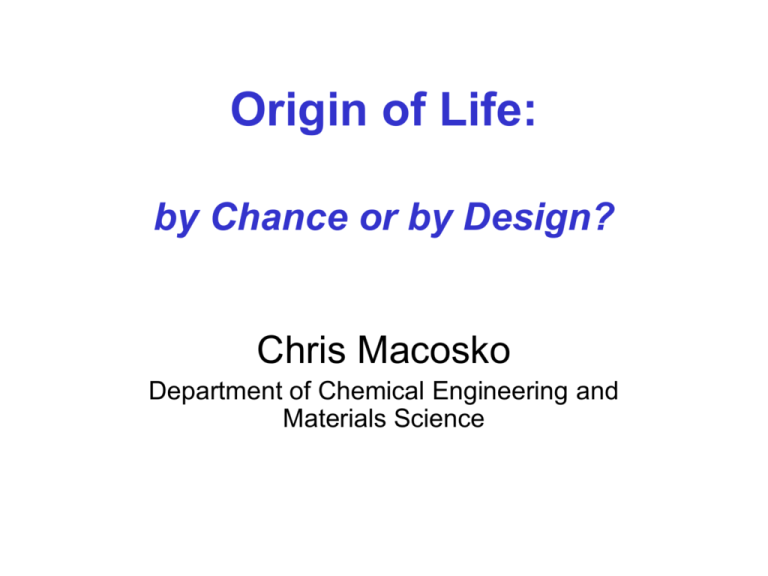Origin of Life
advertisement

Origin of Life: by Chance or by Design? Chris Macosko Department of Chemical Engineering and Materials Science Autobiogenesis: Spontaneous Origin of Life Oparin, Haldane, 1930’s Biology G.B.Johnson and R.H.Raven, 1996 Biology Biggs et. al. Glencoe Pub. 2004. Chap 14.2 Heat Sunlight Electrical energy Proteins and nucleic acids Simple Cells Biochemistry D. Voet & J.G. Voet Wiley 2004 Molecules of aspartic acid with a left-handed orientation, shown in crystal form, could be the "ancestral Eve" of all amino acids -- the building blocks of proteins -in life on Earth. The Origin of Life and the Crystallization of Aspartic Acid in Water Tu Lee* and Yu Kun Lin Department of Chemical and Materials Engineering, National Central University, Taiwan, R.O.C. Cryst. Growth & Design 2010 “The landing site of the Mars rover Curiosity was once covered with fast-moving and possibly waist-high water that could have possibly supported life, NASA scientists announced Thursday.” Star Tribune Sept 28, 2012 Autobiogenesis: Spontaneous Origin of Life Oparin, Haldane, 1930’s Haldane, J. B. S. (John Burdon Sanderson) (1892–1964) known as Jack (but who used 'J.B.S.' in his printed works), was a British-born geneticist and evolutionary biologist. A staunch Marxist, he was critical of Britain's role in the Suez Crisis, and chose to leave Oxford, move to India and become an Indian citizen. He was one of the founders (along with Ronald Fisher and Sewall Wright) of population genetics. Alexander Oparin (1894-1980) The influence of the Marxist theoretical concept of dialectical materialism, part of the Communist Party's official interpretation of Marxism, fit Oparin's definition of life as 'a flow, an exchange, a dialectical unity'. This notion was enforced by Oparin's association with Lysenko. Stanley Miller, 1953 Chemistry graduate student at University of Chicago Adapted from “A Production of Amino Acids under Possible Primitive Earth Conditions,” Stanley L. Miller, Science, Vol. 117, (May 15, 1953), pp. 528-529. General formula for amino acids Table 1-4 Yields from Sparking Mixture of CH4, NH2 , H2O and H2 Autobiogenesis: Spontaneous Origin of Life Research into 1970’s supportive Oparin, Haldane, 1930’s First photograph ever taken from the surface of Mars. Viking 1 Lander July 20, 1976. Primary objectives of the Viking missions - obtain high-resolution images of the Martian surface, - characterize the atmosphere and surface - search for evidence of life on Mars. http://grin.hq.nasa.gov/ABSTRACTS/GPN-2003-00061.html “…recent advances…have thrown serious doubts on the anoxic [oxygen free] model…” —H. Clemmey and N. Badham “Oxygen in the precambrian atmosphere: An evaluation of the geological evidence.” Geology 10(3), 145 (March 1982). “No geological or geochemical evidence collected in the last 30 years favors a strongly reducing primitive atmosphere…Only the success of the laboratory experiments recommends it.” —R.A. Kerr “Origin of life: new ingredients suggested.” Science 210(4465), 42 (October 3, 1980). Autobiogenesis: Spontaneous Origin of Life Oparin, Haldane, 1930’s Can Random Reactions Produce a Protein? Typical protein N = 100-300 How many ways to arrange 100 amino acids, 5 of each type? N! W = # arrangements = n1!n2! n20! 100! 100! 115 10 20 5!5! 5! 10115 different peptides <105 useful for life Can Random Reactions Produce a Protein? How long will it take to create a particular polypeptide? (1041)(1014 rearrange/s)(1017s) = 1072 polypeptides vs. 10115 possible structures fastest chemical reaction age of Earth? Maillard Reactions Degrade Proteins Oparin, Haldane, 1930’s Do We Know Enough to Reconstruct Life In Vitro? M.L. Shuler Department of Biomedical Engineering Cornell University Metabolic Features of the Minimal Cell Model External Medium (31 chemicals) How to Create a Minimal Cell Model Computational Chromosome Proposed Reaction Rates • Gil, et al. gene set (207 protein coding genes) Si = species i • Removed “poorly characterized” genes S = all species • Added rRNA, tRNA, transporter genes p = all parameters • 241 genes total (102 single genes, 19 gene clusters) Ej = enzyme j • smallest real cell = 454 genes • 600 nucleotides/gene Minimum Model Requires: 4 Compartments 241 Genes 408 Chemical Species 570 Reactions 1,176 Reaction Parameters 36 Events and still could not survive in nature temperature, no cell wall must feed 31 chemicals The Enigma of the Origin of Life “The largest stumbling block in bridging the gap between nonliving and living still remains. All living cells are controlled by information stored in DNA, which is transcribed in RNA and then made into protein. This is a very complicated system, and each of these three molecules requires the other two--either to put it together or to help it work. DNA, for example, carries information but cannot put that information to use, or even copy itself without the help of RNA and protein.” Kenneth R. Miller and Joseph Levine, Biology: The Living Science (Upper Saddle River, New Jersey: Prentice Hall), 1998, p.406-407. Did life arise on another planet? Theory of Panspermia – Hoyle and Wickramasinghe 1980’s Stanley Miller: the chemical origin of life is a lot more difficult than we first imaged Father of 'Origin of Life’ Chemistry Dies May 21, 2007 National Geographic 1998 • Antony Flew, a British philosophy professor and leading champion of atheism for more than half a century, changed his mind and became a deist at the age of 81. • He said it was a result of “my growing empathy with the insight of Einstein and other noted scientists” • In an interview with ABC News Flew indicated that a "super-intelligence is the only good explanation for the origin of life and the complexity of nature." Did life begin by chance or by design? – – – – – Huge amount of information in the molecules of life No naturalistic theory for origin of life We know that intelligence can create molecules of life Design is not an argument from ignorance Is a “super intelligence the only good explanation for the origin of life (A. Flew)” ? The world looks more complex to a scientist. The world looks more beautiful to a scientist. Science teaches humility. This comes from an understanding of what we do not know. Belief in a Creator has energized the greatest scientists. Questions for discussion 1. Growing up, what were you taught about the origin of life? 2. This presentation argues that life could not have arisen apart from some sort of design. What do you think about the reasons given? 3. Do you have any questions concerning what was shared personally? 1. Charles Hummel, The Galileo Connection: Resolving Conflicts Between Science and the Bible (1986). Telling the fascinating stories of Copernicus, Kepler, Galileo, Newton, and Pascal, Charles E. Hummel provides a historical perspective on the favorable relationship between science and Christianity. 2. Nancy Pearcey and Charles Thaxton, The Soul of Science: Christian Faith and Natural Philosophy (1994). Pearcey and Thaxton deliver a more accurate portrayal of the origin and progress of science by recognizing the influence of Christianity on science. The popular impression that great discoveries were made despite Christian beliefs is soundly refuted by many historical examples where definitive progress was made within the framework of religious and philosophical ideas. The authors present in a new light the influence of the medieval church upon scientific advancement and demonstrate that Newton, Descartes, and others were working to prove or expand upon their religious principles within the Judeo-Christian world-view. 3. Stanley Miller and Leslie Orgel, The Origins of Life on the Earth (1974). In this book, Miller and Orgel attempt a comprehensive presentation of the chemistry and physics of the early Earth and how it led to the origin of life. Much of the discussion is obviously speculative as the relevant observations are lost to geologic time, but this is tempered with a thorough discussion of the chemistry of the simple organic molecules that have been formed in a variety of prebiotic simulation experiments. The emphasis is decidedly on "what could have happened" given the right conditions and how this could have led towards the origin of life 4. Charles Thaxton, Walter Bradley and Roger Olsen, The Mystery of Life's Origin: Reassessing Current Theories (1984). This book was one of the earlier attempts to critically evaluate the many theories regarding the naturalistic origin of life on the Earth. It is heavy with chemistry and biochemistry but well-written and accessible to most college level science students. It tries to answer the scientifically relevant question, did it really happen this way and not settle for just any plausible mechanism which stretch to the extreme limits of what might be possible. 5. Christopher Wills and Jeffrey Bada, The Spark of Life: Darwin and the Primeval Soup (2000). Biologist Christopher Wills and marine chemist Jeffrey Bada present a lively summary of the research looking for signs of life elsewhere and clues to the origin of terrestrial organisms in The Spark of Life. Their writing is clear and every concept is explained well in terms the layman can understand. Bada's insider status with NASA provides insight not found elsewhere. They examine the full gamut of theories, from extraterrestrial origin to life spilling out of hydrothermal vents to deep-crust genesis, identifying strengths and weaknesses in them all. 6. Raphael Ikan (editor), The Maillard Reaction: Consequences for the Chemical and Life Sciences (1996). This book is a collection of nine chapters, each written by an expert in the particular sub-field, describing various aspects of the Maillard reaction in detail. Chapters include discussions of the geochemical aspects, thermal processes, impacts of the Maillard reaction on the nutritional value of food, genotoxicity and more. This book was written for graduates students and research scientists, not for the novice reader.





